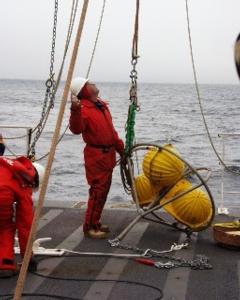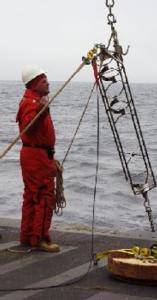12 June, 2000
12 June 2000
Mooring - Part II.
We awoke today to a much calmer ride - we were in the ice. We headed back
out of it early to find suitable water for the open ocean, anchor-last
deployment for the test mooring discussed yesterday. Seabeam was used to
locate a suitable target location (see Janice’s or Susan’s journal about
Baby Knoll for a discussion of Seabeam). Then the Healy sailed three
nautical miles past the target point so that it could lay out the mooring on
its way to the target.
If you were like me, you probably envisioned them putting one end in the
water and letting the rest just play out until the whole mooring was off the
ship. Well, it is a bit more complicated than that! Because of the size,
weight and tension involved, each piece of the mooring is attached while the
mooring is held fast to the ship by ropes, then raised off the deck using an
A-frame hoist and a powered capstan. Once attached, each section is then
lowered into the sea off the stern of the ship. This is repeated until each
piece of the mooring has been attached to the ever-lengthening line in the
water. Picture it this way - to make this chain out of a bunch of friends
you would tie a 20m rope to one friend and they would jump in the water (not
here, they would die of hypothermia!) Then another friend holding on to the
end of that 20m piece of rope and tied to a second 20m piece of rope would
wait until the first piece is near its end before they jump in. This
continues until all the friends have jumped in, or in the mooring’s case,
until the pieces have been attached. For this 200m test mooring, this took
about an hour and a half. According to John Kemp, the 4000m moorings he has
done have taken as much as 23 hours!
After the mooring had been underwater for three hours, we went to recover
it. After deployment, John and Jeff had used a system of triangulating the
anchor’s position based on signals sent from the transponder. A signal is
sent and returned from the transponder telling how far away it is from the
ship. This is repeated at three other points and if you then draw a circle
around each of the points representing their distances from the transponder,
the circles will intersect showing you the transponder/mooring’s location.
This gives researchers and exact point to return to when they wish to
retrieve their mooring, which may be as much as a year after it was
deployed. When John triggered the transponder to release the mooring it
popped up about 100m off the starboard side of the ship. Perfection! You
want it close to the ship, but not banging underneath it. Then, because it
would be difficult to reach the floats from the deck of the ship, a small
boat was lowered from the HEALY to attach a line with a hook to the top
float cage.
Once the float assembly is hooked up, bringing the mooring back on board is
like sending it off. Each section is pulled on board and each part is taken
off and secured. It is important to secure (attach) things to the deck or
they can roll around causing serious injury. This is the same whether you
are in a 420’ icebreaker or a pleasure boat out on the lake. Once
everything was secured, we were back underway headed for the ice. This test
appeared to be a success.
Tomorrow we will do the anchor first deployment of the test mooring, but
this time we will be operating in the ice. How do you think this will
differ from today’s mooring exercise? Check in tomorrow to see!
p.s. Good luck to all my students on their final exams!!!!!

Finally the anchor goes over the stern.

A string of bubbles is the next thing over.

BM3 Carl Schultz (l) and Seaman Michael Rose (r) work the capstan which aided in moving the equipment during the mooring.

Next up is the sediment trap which is the last thing above the transponder and anchor.

John directs the movement of the top floats, the first thing over in this trial.

This housing being attached by John would normally have a current meter or other recording device within it.

John Kemp and Jeff Lord of Woods Hole Oceanographic Institute wait to get the mooring underway.

The small boat team places a hook and line onthe mooring's top floats.
Contact the TEA in the field at
.
If you cannot connect through your browser, copy the
TEA's e-mail address in the "To:" line of
your favorite e-mail package.
|
